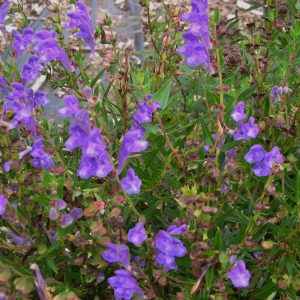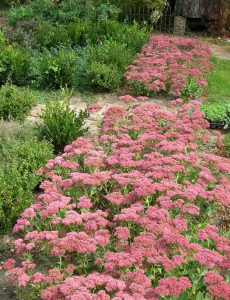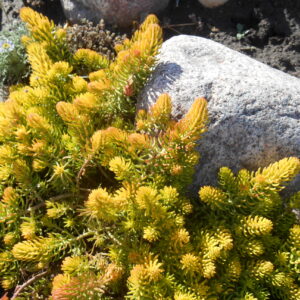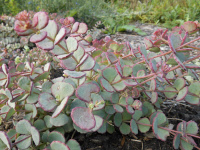Our Plants
Showing 521–528 of 616 results
-
Scutellaria altissima Somerset skullcap Z 4-10
In early summer masses of upright stems bearing bi-colored, bluish-purple and white, snapdragon-like flowers, the hood being bluish-purple and the lower lip white. Flowers grow on one side of the spike. This will re-bloom if you cut the flowers.
In early summer masses of upright stems bearing bi-colored, bluish-purple and white, snapdragon-like flowers, the hood being bluish-purple and the lower lip white. Flowers grow on one side of the spike. This will re-bloom if you cut the flowers.
Size: 24-36” x 18-24”
Care: sun to part shade in moist well-drained to well-drained soil
Native: central & eastern Europe
Wildlife Value: pollen and nectar attracts bees and butterflies1st described and named in 1700 by Joseph Pitton Tournefort, French botanist.
-
Scutellaria baicalensis Chinese skullcap Z 4-8
Spikes of purplish-blue trumpets all summer into fall
Spikes of purplish-blue trumpets all summer into fall
Size: 12” x 12”
Care: sun in moist well-drained soil
Native: eastern Asia, SiberiaLinnaeus’ imaginative mind named this genus after the Latin sculellum meaning “a little dish,” because of its resemblance to the flower’s helmet-shaped calyx. In its native China called huang-chin. Used medicinally since ancient times in China to cure colds, fever, headaches and insomnia. William Robinson, father of the mixed perennial border, described the flowers and use of skullcap as having “rich velvety dark blue flowers.”
-
Scutellaria diffusa Turkish skullcap Z 5-10
Small snapdragonish violet flowers with white markings on two adjacent lower lips looking like an open book in summer along short stems. Flower clusters top tidy mounds of sage-colored, oval, hairy leaves.
OUT OF STOCK
Small snapdragonish violet flowers with white markings on two adjacent lower lips looking like an open book in summer along short stems. Flower clusters top tidy mounds of sage-colored, oval, hairy leaves.
Size: 4-6” x 12”
Care: sun in well-drained soil
Native: Turkey, Lebanon and Syria
Wildlife Value: deer resistantFirst published by Swiss botanist A.P.de Candolle in Prodr. 12: 421 (1848)
-
Scutellaria incana syn. Scutellaria canescens, Scutellaria villosa Downy skullcap Z 5-8
Showy, open spikes of two-lipped Blue-violet florets from June-Sept
Flowers of spikes of purple-blue tubes ending in two open lips, the lower lip having a white blotch, blooming for months from July to September, if deadheaded
Size: 2-3’ x 12-18"
Care: sun to part shade in moist well-drained to well-drained soil. Reblooms if deadhead after 1st flush of flowers
Native: NY to WI, Georgia to TX, Wisconsin native
Wildlife Value: Deer resistant. Its nectar feeds small butterflies, Bumblebees and Hummingbirds.The name Scutellaria is from Latin scutella meaning a small dish or saucer referring to the shape of the persistent calyx, a covering at the flower’s base. Incana means grey referring to the tiny hairs on stems and undersides of leaves giving a greyish color. Named by Johann Friedrich Theodor Biehler, German botanist from the plant specimens in Christian Sprengel’s (1750-1816) herbarium in 1807. How did German botanist Sprengel, who never set foot in America, come to have a pressed specimen of this native American plant? Sprengel and German botanist Carl Ludwig Willdenow (1765-1812) were close collaborators. Another German botanist Heinrich Ernst Muhlenberg (1753-1815), living in Lancaster Pennsylvania, sent many American plants specimens to Willedenow. Scutellaria incana is native to and grows in what is now called Muhlenberg Meadow in Lancaster County PA. These connections make it likely that the specimen Biehler saw came from Henry Muhlenberg.
-
Scutellaria resinosa syn. Scutellaria wrightii Prairie skullcap Z 4-9
Two-lipped, deep violet-blue tubes bloom from spring to fall
Two-lipped, deep violet-blue tubes bloom from spring to fall
Size: 10” x 10”
Care: sun to part shade in well-drained to moist well-drained soil, drought tolerant
Native: Colorado, NM, KS, Oklahoma, TX, collected on the Canadian River, tributary of Arkansas River
Wildlife Value: deer & rabbit resistant. Nectar and pollen attract butterflies and bees.Described by botanist John Torrey in Annals of the Lyceum of Natural History of NY 2: 232 (1828)
-
Sedum ‘Autumn Joy’ syn ‘Herbstfreude’ syn Hylotelephium ‘Autumn Joy’ Z 4-9
Classic, large flat flower heads turn from green to rose
Classic, large flat flower heads turn from green to rose blooming in September and October. A staple for autumn in the garden.
Size: 30” x 12”
Care: full sun in well-drained soil
Awards: England’s Royal Horticultural Society Award of Garden Merit.Sedum means “plant that sits.” “Live forever” is an ancient Greek name for sedums. The Roman Pliny claimed that sedum’s juice treated wounds. In the 1500’s English herbalist Gerard called sedums “very full of life,” referring to succulent’s quality of being very easy to grow. Autumn Joy introduced to gardens before 1920 by the George Arends Nursery in Ronsdorf, Germany.
-
Sedum rupestre ‘Angelina’ syn. Sedum reflexum ‘Angelina’ Spruce-leaved stonecrop Z 4-8
Chartreuse, turning red-orange in fall, needle-like leaves blooming with yellow flowers June-August but the leaves are the feature.
Chartreuse, turning red-orange in fall, needle-like leaves blooming with yellow flowers June-August but the leaves are the feature.
Size: 4-6” x 1-2’ spreader
Care: sun in well-drained to moist well-drained soil.
Wildlife Value: Rabbit and Deer resistant. Drought tolerant.Species grown at America’s 1st botanic garden, Elgin Botanic Garden 1811
-
Sedum sieboldii syn Hylotelephium sieboldii, October Daphne Z 3-9
Fleshy gray-green foliage edged with pink encircles the prostrate stems, flowering strawberry pink in fall. Perfect for rock gardens, front of border, fairy gardens, roof gardens, troughs and groundcover or anyplace with drought.
Fleshy gray-green foliage edged with pink encircles the prostrate stems, flowering strawberry pink in fall. Perfect for rock gardens, front of border, fairy gardens, roof gardens, troughs and groundcover or anyplace with drought.
Size: 4" x 8"
Care: full sun in moderately fertile, well-drained soil.
Native: Japan
Wildlife Value: Drought tolerant and deer resistant.
Awards: Elisabeth Carey Miller Botanical Garden Great Plant PickSedum means “plant that sits.” “Live forever” is an ancient Greek name for sedums. The Roman Pliny claimed that sedum’s juice treated wounds. In the 1500’s English herbalist Gerard called sedums “very full of life,” referring to succulent’s quality of being very easy to grow. This species named for its discoverer, Dr. Philipp Franz von Siebold (1791-1866). Von Siebold, a German doctor, worked for the Dutch East India Company as its resident physician on Deshima Island, off the coast of Japan. He boldly became too knowledgeable about Japanese affairs and was imprisoned by the Japanese in 1826 and then banished in 1828. When he left he carried nearly 500 plants with him to Europe. William Robinson, father of the mixed perennial border, described Sedum sieboldii as beautiful. He advised gardeners to grow it “in strong loam and mortar rubble in fully exposed positions (and use it as) an excellent plant for vases in summer.”





